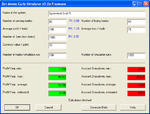I see that we have a thread going with some good discussion on backtesting, but I wanted to ask about going forward in time, specifically, how do you evaluate forward testing? Here's my situation.
For the past 6 months I've been forward testing on paper a system that I developed for commodities. The trades are all one day trades, enter on the market's open and exit on the close with no stops or profit targets. I don't think it's optimized. I've made 59 total trades over this 6 month time and the equity curve is pretty solid with a decent distribution There was large draw down near the start where I went negative but the system recovered nicely. I've had 26 losses and 33 wins. There haven't been any real big outliers.
If I could backtest this a year or two I would be pretty happy but I don't have anyway of doing that, so I'm pretty much stuck with just going forward. How long you would you folks take something like this forward? A year, 10 months, 2 years? I feel that since these are just one day trades that maybe my testing time doesn't need to be overly long, maybe another couple of months. I would like to get everyone's feedback and opinions though.
For the past 6 months I've been forward testing on paper a system that I developed for commodities. The trades are all one day trades, enter on the market's open and exit on the close with no stops or profit targets. I don't think it's optimized. I've made 59 total trades over this 6 month time and the equity curve is pretty solid with a decent distribution There was large draw down near the start where I went negative but the system recovered nicely. I've had 26 losses and 33 wins. There haven't been any real big outliers.
If I could backtest this a year or two I would be pretty happy but I don't have anyway of doing that, so I'm pretty much stuck with just going forward. How long you would you folks take something like this forward? A year, 10 months, 2 years? I feel that since these are just one day trades that maybe my testing time doesn't need to be overly long, maybe another couple of months. I would like to get everyone's feedback and opinions though.

